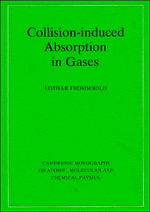5 - Theory: monatomic gas mixtures
Published online by Cambridge University Press: 23 September 2009
Summary
The theory of collision-induced absorption developed by van Kranendonk and coworkers and other authors has emphasized spectral moments (sum formulae) of low order. These are given in closed form by relatively simple expressions which are readily evaluated. Moments can also be obtained from spectroscopic measurements by integrations over the profile so that theory and measurement may be compared. A high degree of understanding of the observations could thus be achieved at a fundamental level. Moments characterize spectral profiles in important ways. The zeroth and first moments, for example, represent in essence total intensity and mean width, the most striking parameters of a spectral profile.
While spectral moments permit significant comparisons between measurements and theory, it is clear that some information is lost if a spectroscopic measurement is reduced to just one or two numbers. Furthermore, for the determination of experimental moments, substantial extrapolations of the measured spectra to low and high frequencies are usually necessary which introduce some uncertainty, even if large parts of the spectra are known accurately. For these reasons, line shape computations are indispensible for detailed analyses of measured spectra, especially where the complete absorption spectra cannot be measured. Moreover, one might expect that the line shape of the induced spectra, with its ‘differential’ features like logarithmic slopes and curvatures and the dimer structures, depend to a greater degree on the details of the intermolecular interactions than the spectral moments.
- Type
- Chapter
- Information
- Collision-induced Absorption in Gases , pp. 195 - 278Publisher: Cambridge University PressPrint publication year: 1994

